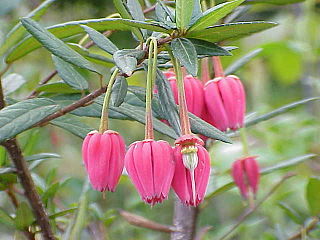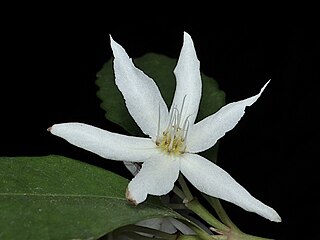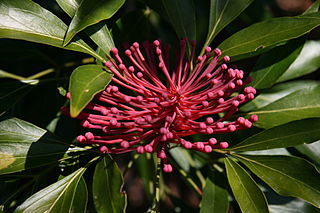
Boronia is a genus of about 160 species of flowering plants in the citrus family Rutaceae. Most are endemic to Australia with a few species in New Caledonia, which were previously placed in the genus Boronella. They occur in all Australian states but the genus is under review and a number of species are yet to be described or have the description published. Boronias are similar to familiar plants in the genera Zieria, Eriostemon and Correa but can be distinguished from them by the number of petals or stamens. Some species have a distinctive fragrance and are popular garden plants.

Elaeocarpaceae is a family of flowering plants. The family contains approximately 615 species of trees and shrubs in 12 genera. The largest genera are Elaeocarpus, with about 350 species, and Sloanea, with about 120.

Austrobaileya is the sole genus consisting of a single species that constitutes the entire flowering plant family Austrobaileyaceae. The species Austrobaileya scandens grows naturally only in the Wet Tropics rainforests of northeastern Queensland, Australia.

Geijera is a genus of shrubs and trees in the family Rutaceae and are native to New Guinea, Australia and New Caledonia. They have simple leaves arranged alternately, panicles of bisexual flowers usually with five, sometimes four, sepals, petals and stamens and fruit containing shiny black seeds.

Eupomatia is a genus of three species of plants in the ancient family Eupomatiaceae, and is the sole genus in the family. Eupomatiaceae is recognised by most taxonomists and classified in the plant order Magnoliales. The three described species are shrubs or small trees, native to the rainforests and humid eucalypt forests of eastern Australia and New Guinea. The type species Eupomatia laurina was described in 1814 by Robert Brown.

Tasmannia lanceolata, commonly known as pepper tree, native pepper, mountain pepper or mountain pepperbush, is a species of flowering plant in the family Winteraceae, and is endemic to south-eastern Australia. It is a dioecious bushy shrub to small tree with lance-shaped or narrowly ellipic leaves, male and female flowers on separate plants, the flowers with 3 to 9 petals, and the fruit a deep maroon to glossy black berry.

Tasmannia stipitata, commonly known as northern pepperbush is a flowering plant in the family Winteraceae and is endemic to eastern Australia. It has narrowly lance-shaped to narrowly elliptic leaves and male and female flowers on separate plants, the male flowers with 21 to 65 stamens and the female flowers with 2 to 9 carpels. The fruit is bluish-violet and contains 12 to 15 seeds.

Epipogium, commonly known as ghost orchids, is a genus of four species of terrestrial leafless orchids in the family Orchidaceae. Orchids in this genus have a fleshy, underground rhizome and a fleshy, hollow flowering stem with small, pale coloured, drooping, short-lived flowers with narrow sepals and petals. They are native to a region extending from tropical Africa to Europe, temperate and tropical Asia, Australia and some Pacific Islands.

Crepidium, commonly known as 沼兰属 or spur orchids is a genus of about three hundred species of orchids in the family Orchidaceae. Plants in this genus are evergreen, mostly terrestrial plants with short stems lying on the ground, two or more relatively large, pleated leaves and small, non-resupinate flowers with spreading sepals and petals. The genus is widely distributed in the tropics.

Corymborkis, commonly known as cinnamon orchids, or 管花兰属 is a genus of eight species of orchids in the family Orchidaceae. They are evergreen, terrestrial plants which grow in clumps and have thin roots, leafy stems, pleated leaves and widely-opening flowers with thin, spreading sepals and petals. They are widely distributed in the tropics.
Eucryphia jinksii, the Springbrook leatherwood, is a species of rare rainforest trees found in Queensland and New South Wales, Australia, of the plant family Cunoniaceae.

Semecarpus australiensis, commonly known as the tar tree, native cashew, marking nut, or cedar plum, is a species of tree in the cashew, sumac and mango family Anacardiaceae, native to parts of Melanesia and northern Australia. Contact with the plant can cause serious allergic reactions, a common characteristic of this family.

Schizomeria ovata, a medium to large Australian rainforest tree, is widespread in warm-temperate rainforest in coastal New South Wales north from Narooma and southern Queensland south from Fraser Island. It is also found in Papua New Guinea and the Solomon Islands.

Doryphora sassafras, commonly known as sassafras, yellow sassafras, golden deal or golden sassafras, is a species of flowering plant in the Southern Sassafras Family Atherospermataceae and is endemic to eastern Australia. It is a shrub to tree with elliptic or egg-shaped leaves and contrasting white flowers which occur in autumn and winter.

Elaeocarpus bancroftii, commonly known as Kuranda quandong, Johnstone River almond, ebony heart, grey nut, or nut tree is a large rainforest tree in the family Elaeocarpaceae which is endemic to Queensland. It has coriaceous leaves, attractive white flowers and relatively large fruit containing an edible kernel.

Atractocarpus benthamianus is a species of flowering plant in the family Rubiaceae growing in eastern Australia, commonly known as native gardenia. It is an understorey species of subtropical and tropical rainforest on fertile soils. The natural range of distribution is from Forster, New South Wales to central Queensland. This plant features beautifully scented flowers.

Pseuderanthemum variabile, commonly known as pastel flower or love flower in its native range, or night and afternoon in the USA, is a small perennial herb in the family Acanthaceae which is native to Australia, Papua New Guinea and New Caledonia. It can be an unwelcome nuisance in orchid nurseries in Australia.

Alloxylon pinnatum, known as Dorrigo waratah, is a tree of the family Proteaceae found in warm-temperate rainforest of south-east Queensland and northern New South Wales in eastern Australia. It has shiny green leaves that are either pinnate (lobed) and up to 30 cm (12 in) long, or lanceolate (spear-shaped) and up to 15 cm (5.9 in) long. The prominent pinkish-red flower heads, known as inflorescences, appear in spring and summer; these are made up of 50 to 140 individual flowers arranged in corymb or raceme. These are followed by rectangular woody seed pods, which bear two rows of winged seeds.

Pleioluma queenslandica, the blush condoo, is a large rainforest tree of the family Sapotaceae native to eastern Australia. It is found in sea side rainforest as well as the drier inland rainforests. From as far south as the Richmond River, New South Wales to Coen in tropical Queensland, and as far west as Melville Island, Northern Territory.

Bouchardatia is a genus of two species of tree in the family Rutaceae, one species endemic to eastern Australia, the other to New Guinea. They have compound leaves with three or five leaflets, and are arranged in opposite pairs. The flowers are bisexual, arranged in panicles, each flower with four sepals, four petals and eight stamens, the petals and stamens all free from each other. The fruit has up to four ridged follicles fused at the base, each containing a single seed.



















